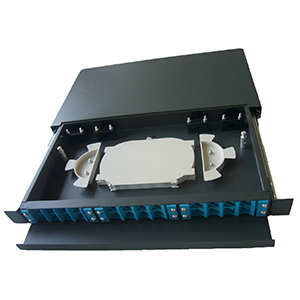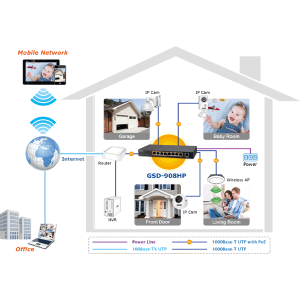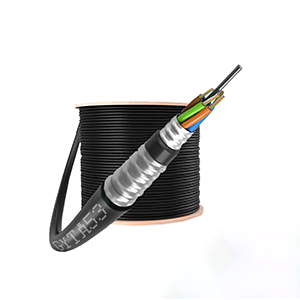Fiber optic cables play an important role in modern communication networks. This article will focus on the characteristics of 12-core fiber optic cables. We will first define the structural composition and working principle of fiber optic cables, and explain the main application scenarios of fiber optic cables with different core counts. Next, we will analyze the advantages of 12-core fiber optic cables in terms of transmission capacity, space utilization, reliability, and cost-effectiveness.
We will explain how 12-core fiber optic cables can meet the growing demand for network bandwidth, improve the deployment efficiency of fiber optic networks, ensure the stability and service quality of network systems, and improve the economy of fiber optic network construction and operation and maintenance. We will explain the application of 12-core fiber optic cables in data centers, 5G, FTTx and other fields, and analyze its advantages in different scenarios. Finally, we will provide key factors and precautions for selecting 12-core fiber optic cables, and introduce precautions in actual deployment.
Basic concepts of fiber optic cables
Let me introduce you to the basic concepts of fiber optic cables.
Structural composition and working principle of optical fiber cable:
(1) Structural composition:
- Optical fiber cable consists of optical fiber core, cladding, buffer layer, sheath and other parts
- The optical fiber core is responsible for the transmission of optical signals, and other layers provide protection and reinforcement
(2) Working principle:
- The optical signal is transmitted in the optical fiber core through total reflection
- The cladding and buffer layer ensure that the optical signal will not leak or attenuate
- The outer sheath provides mechanical strength and environmental protection
In general, optical fiber cable uses the total reflection principle in the optical fiber core to achieve long-distance low-loss transmission of optical signals, and ensures its reliability and stability through the overall design of the multi-layer structure.
Main application scenarios of optical fiber cables with different core counts:
(1) Single-core optical fiber cable
- Applicable to scenarios requiring single-channel high-speed transmission
- Such as point-to-point long-distance network transmission, PON access network, etc.
(2) Dual-core optical fiber cable
- Provides bidirectional transmission, suitable for applications requiring redundancy
- Such as LAN environments such as enterprise parks and campus networks
(3) Multi-core fiber optic cable
- Including 4-core, 8-core, 12-core and other different core counts
- Suitable for application scenarios that require high-capacity transmission
- Such as internal networks in data centers, 5G base station optical transmission, etc.
In short, fiber optic cables with different core counts have their own characteristics in terms of bandwidth requirements, redundancy, and installation convenience, and need to be selected according to actual application scenarios and needs.
Features of 12-core fiber optic cable
Let me introduce the main features of 12-core fiber optic cable in detail:
Transmission capacity:
- 12-core fiber optic cable can provide higher total bandwidth and signal transmission capacity
- Each fiber can support a transmission rate of up to 10Gbps
- This high capacity feature is very suitable for meeting the growing demand for network bandwidth
Space utilization:
- 12-core fiber optic cable is smaller and lighter in size and weight
- Compared with single-core or 4-core cables, it can greatly improve the efficiency of fiber optic deployment
- It has obvious advantages in computer room wiring, pipeline laying, etc.
Reliability:
- 12-core fiber optic cable has excellent mechanical strength and tensile strength
- The outer protective structure can resist damage from harsh environments
- Ensures long-term stable operation and service quality of the network system
Cost-effectiveness:
- 12-core fiber optic cable has lower unit cost
- Due to higher space utilization, the construction cost is relatively lower
- These advantages help improve the economy of fiber optic network construction and operation and maintenance
In general, 12-core fiber optic cable has become an ideal choice for building high-speed fiber optic networks with its excellent transmission capacity, space utilization, reliability and cost-effectiveness.
Application scenarios of 12-core fiber optic cable
Let me summarize the advantages of 12-core fiber optic cable in the main application scenarios:
Data center:
- Data center has a strong demand for high-density, high-bandwidth optical transmission
- 12-core fiber optic cable can provide large-capacity transmission in limited wiring space
- Its compact size and light weight can also simplify the internal wiring of the computer room
5G network:
- 5G base stations have strict requirements for high-speed, low-latency optical transmission
- 12-core fiber optic cable can meet the large-capacity transmission requirements of 5G network
- At the same time, its excellent environmental adaptability also meets the requirements of outdoor deployment
FTTx access network:
- FTTx network needs to provide stable optical transmission from the central office to the user end
- 12-core fiber cable can provide sufficient capacity in the trunk and branch segments
- And with its reliability, it ensures the service quality of the entire access network
Enterprise/campus network:
- Enterprises and campuses have high requirements for network bandwidth and reliability
- The high capacity and anti-interference performance of 12-core fiber cable can meet these requirements
- At the same time, its easy construction and deployment characteristics also simplify network deployment
In short, the excellent performance of 12-core fiber cable makes it widely used in high-speed and high-density optical communication scenarios such as data centers, 5G, and FTTx. It can effectively meet the stringent requirements of these fields for high bandwidth and high reliability.
Selection and deployment of 12-core fiber optic cables
Let me summarize the key factors and considerations that should be considered when selecting and deploying 12-core fiber optic cables.
Precautions for selecting 12-core fiber optic cable:
(1) Fiber type
- Determine the required single-mode or multi-mode fiber type
- Ensure compatibility with the optical interfaces of other network devices
(2) Optical performance
- Focus on optical indicators such as optical insertion loss and return loss
- Ensure that the system’s requirements for signal transmission quality are met
(3) Mechanical properties
- Pay attention to mechanical indicators such as cable flexibility and tensile strength
- Ensure that the cable can adapt to the mechanical load of the installation environment
(4) Environmental adaptability
- Pay attention to environmental indicators such as cable temperature, humidity, and waterproofness
- Ensure that it can meet the requirements of the actual use environment
Deployment precautions for 12-core optical fiber cables:
(1) Path selection
- Choose a flat, barrier-free cable laying path
- Try to avoid excessive bending or stress on the cable
(2) Connection method
- Ensure that the MPO connector is correctly docked and fixed
- Check whether the connection is sealed and waterproof
(3) Fixing method
- Use appropriate fixing methods, such as clamps, cable ties, etc.
- Ensure that the cable is not subjected to excessive mechanical stress
(4) Label management
- Make good labeling and record of cables for subsequent maintenance
- Mark key information such as path, length, connection, etc.
(5) Protection measures
- Take necessary protection measures, such as pipe corridors and pipelines
- Prevent cables from external damage and environmental damage
In short, when selecting and deploying 12-core fiber optic cables, it is necessary to fully consider factors such as their optical performance, mechanical characteristics, and environmental adaptability, and take appropriate installation and protection measures to ensure that they can perform at their best in actual applications.
Summary
12-core fiber optic cable plays a key role in building high-capacity and high-reliability optical networks. Our company has long focused on the research and development and production of optical communication equipment and its supporting products, and has rich industry experience. The 12-core fiber optic cable products we provide have reached the industry-leading level in terms of transmission capacity, space utilization, reliability and cost-effectiveness, and can meet your demanding needs for high-speed and efficient network construction.
Whether you need to deploy 12-core fiber optic cable in a data center, 5G network, or FTTx, we can provide you with customized solutions. At the same time, our professional team will provide you with a full range of technical support, including on-site surveys, solution design, and equipment installation and maintenance. Contact us now to learn more about the application of 12-core fiber optic cable.
12 Core Optical Fiber Cable FAQ
A 12-core optical fiber cable is a fiber optic cable containing 12 individual optical fibers bundled together in a single cable sheath.
12-core fiber cables are widely used in high-bandwidth applications like data centers, telecommunications networks, and fiber-to-the-home (FTTH) deployments.
Benefits include higher fiber density, easier cable management, reduced installation time, and lower overall infrastructure costs.
Both singlemode and multimode fiber variants are available, with the choice depending on the specific network requirements.
The higher fiber count enables more efficient use of cable pathways and enhanced scalability for growing bandwidth needs.
The most common connector is the MPO (multi-fiber push-on) type, which provides a compact high-density interface.
Proper handling, slack management, and connector cleaning are critical to ensure reliable performance.
Testing methods include end-to-end insertion loss measurement and fault location using OTDR (optical time-domain reflectometry).
Lengths can range from a few meters up to several kilometers, depending on the application and deployment environment.
Advancements in fiber types, connector designs, and installation techniques may further enhance the performance and deployment of 12-core fiber cables.




